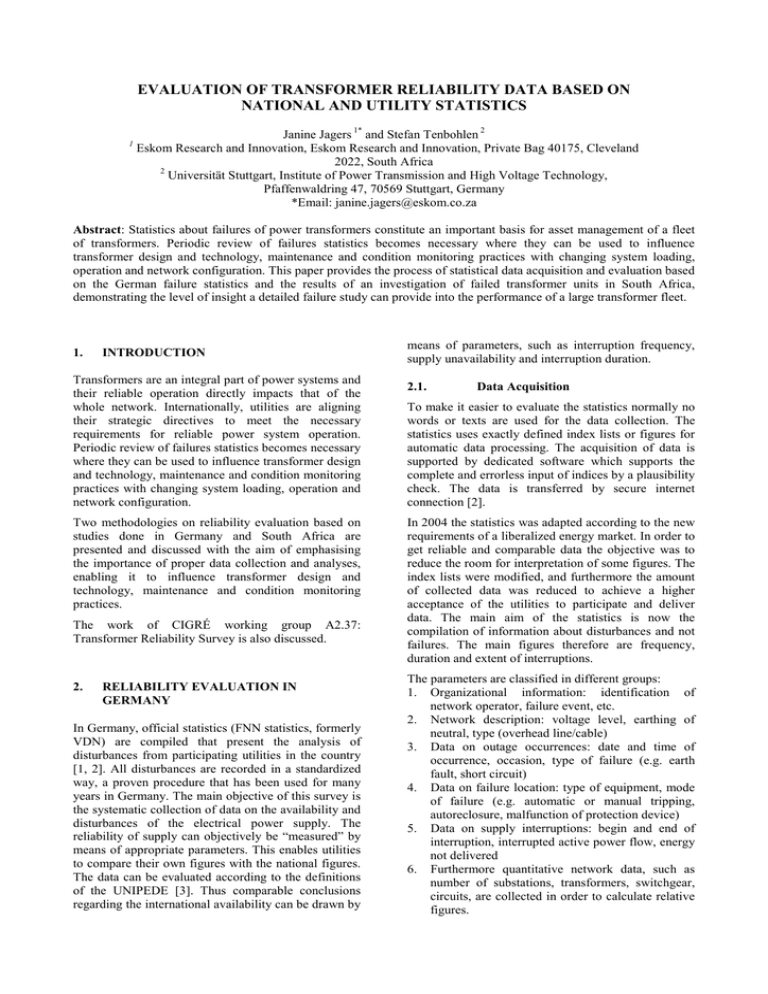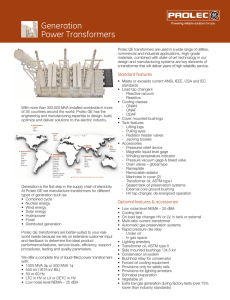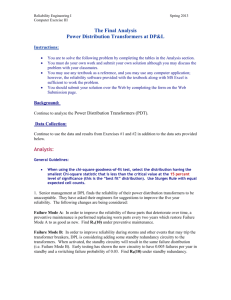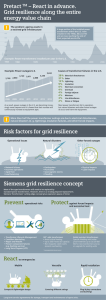evaluation of transformer reliability data based on national and utility
advertisement

EVALUATION OF TRANSFORMER RELIABILITY DATA BASED ON NATIONAL AND UTILITY STATISTICS 1 Janine Jagers 1* and Stefan Tenbohlen 2 Eskom Research and Innovation, Eskom Research and Innovation, Private Bag 40175, Cleveland 2022, South Africa 2 Universität Stuttgart, Institute of Power Transmission and High Voltage Technology, Pfaffenwaldring 47, 70569 Stuttgart, Germany *Email: janine.jagers@eskom.co.za Abstract: Statistics about failures of power transformers constitute an important basis for asset management of a fleet of transformers. Periodic review of failures statistics becomes necessary where they can be used to influence transformer design and technology, maintenance and condition monitoring practices with changing system loading, operation and network configuration. This paper provides the process of statistical data acquisition and evaluation based on the German failure statistics and the results of an investigation of failed transformer units in South Africa, demonstrating the level of insight a detailed failure study can provide into the performance of a large transformer fleet. 1. INTRODUCTION Transformers are an integral part of power systems and their reliable operation directly impacts that of the whole network. Internationally, utilities are aligning their strategic directives to meet the necessary requirements for reliable power system operation. Periodic review of failures statistics becomes necessary where they can be used to influence transformer design and technology, maintenance and condition monitoring practices with changing system loading, operation and network configuration. Two methodologies on reliability evaluation based on studies done in Germany and South Africa are presented and discussed with the aim of emphasising the importance of proper data collection and analyses, enabling it to influence transformer design and technology, maintenance and condition monitoring practices. The work of CIGRÉ working group A2.37: Transformer Reliability Survey is also discussed. 2. RELIABILITY EVALUATION IN GERMANY In Germany, official statistics (FNN statistics, formerly VDN) are compiled that present the analysis of disturbances from participating utilities in the country [1, 2]. All disturbances are recorded in a standardized way, a proven procedure that has been used for many years in Germany. The main objective of this survey is the systematic collection of data on the availability and disturbances of the electrical power supply. The reliability of supply can objectively be “measured” by means of appropriate parameters. This enables utilities to compare their own figures with the national figures. The data can be evaluated according to the definitions of the UNIPEDE [3]. Thus comparable conclusions regarding the international availability can be drawn by means of parameters, such as interruption frequency, supply unavailability and interruption duration. 2.1. Data Acquisition To make it easier to evaluate the statistics normally no words or texts are used for the data collection. The statistics uses exactly defined index lists or figures for automatic data processing. The acquisition of data is supported by dedicated software which supports the complete and errorless input of indices by a plausibility check. The data is transferred by secure internet connection [2]. In 2004 the statistics was adapted according to the new requirements of a liberalized energy market. In order to get reliable and comparable data the objective was to reduce the room for interpretation of some figures. The index lists were modified, and furthermore the amount of collected data was reduced to achieve a higher acceptance of the utilities to participate and deliver data. The main aim of the statistics is now the compilation of information about disturbances and not failures. The main figures therefore are frequency, duration and extent of interruptions. The parameters are classified in different groups: 1. Organizational information: identification of network operator, failure event, etc. 2. Network description: voltage level, earthing of neutral, type (overhead line/cable) 3. Data on outage occurrences: date and time of occurrence, occasion, type of failure (e.g. earth fault, short circuit) 4. Data on failure location: type of equipment, mode of failure (e.g. automatic or manual tripping, autoreclosure, malfunction of protection device) 5. Data on supply interruptions: begin and end of interruption, interrupted active power flow, energy not delivered 6. Furthermore quantitative network data, such as number of substations, transformers, switchgear, circuits, are collected in order to calculate relative figures. The data collected in the FNN disturbance and availability statistics give the answer to a lot of questions, but there are numerous technical problems left that require even more data. Especially the definition and use of modern asset management procedures causes a wide and varied number of questions which often can not be answered by the FNN-statistics or by any statistics at all. It is not possible to extend the standardized disturbance descriptions without an unjustifiable waste of time and money. Therefore detailed statistics about the failure location in the respective equipment, failure cause or mode and repair activities are not included. The individual requirements are difficult to agree and normally these data are strictly confidential. 2.2. Reliability of Power Transformers In 2004 the disturbance statistics recorded about 50 % of the length of the medium and high voltage grid and about 60 % in the area of highest voltage (220 kV and 380 kV) [3]. In terms of numbers 3894 pieces of 110 kV transformers and 499 pieces of 220 and 380 kV transformers are included. In table 1 the disturbance rates of these transformers are shown. Most of the disturbances are not connected with a failure of the transformer. The failure rate is 0.31 % or the 110 kV units and 0.64% for the 220 kV and 380 kV units. Table 1: Disturbance rates of transformers in 2004 [3] 110 kV without failure 110 kV with failure 110 kV percentage of all disturbances 220/380 kV without failure 220/380 kV with failure 220/380 kV percentage of all disturbances 3. Without supply interruption With supply interruption 0.77 % 0.65 % 0.2 % 0.11 % 9.5 % 14.4 % 6.4 % - 0.64 % - 6.3 % - 3.1. Data Acquisition & Classification The approach taken was similar to that of the first international survey on reliability of power transformers [10]. In the first instance, the terminology associated with failure were defined in [8] and included terms such as failure, failure with forced outage, failure with scheduled outage, failure rate, failure location, failure cause and failure mode. Failure was further classified into three levels of severity as severe, intermediate and minor failures. Severe failures are those failures which necessitated the removal of the transformer for repair or replacement. Intermediate failures are those which were possible to repair onsite, but usually required intrusive work on the transformer itself. Minor failures typically cover trip events which occurred as a result of the failure of secondary plant on a transformer and not affecting a transformer’s major components. The classification of failures was to a large extent based on a standard failure reporting form developed by CIGRÉ [11], in which information was grouped into three categories giving the equipment description, operational history and description of failure. Failure cause and failure mode classification were based on predetermined classifiers provided in [11]. This methodology enabled the detailed analysis and classification of more than 200 failures in ± 10,000 unit-years, for variously rated transformers, over the period 1996 to 2006. 3.2. Performance with Age The nature of the failure rate with age is given by the hazard function, and provides useful information regarding equipment life distribution. Periods that could be identified from the hazard function are higher failure rates in early life that could be associated with design or manufacturing problems, constant or low failure rates representing normal life and increasing failure rates after a certain age which can be associated with end of life wear out failures. RELIABILITY EVALUATION IN A SOUTH AFRICAN UTILITY 1.00 0.90 0.80 0.70 0.60 Failure Rate In 1997 a study was conducted that classified transformer failures occurring in the period 1985 to 1995 into the most prominent failure modes [4]. In 2006 this investigation was extended for units failing in the period 1996 to 2006 and was based on failure study of known generator step-up (GSU), transmission and distribution transformer failures. The results of this investigation are presented and discussed in terms of performance with age, failure locations, causes and failure modes [5, 6, 7 & 8]. Performance with age included evaluation of the hazard function, probability density function and survival function. According to [9] studies of this nature provide a more realistic failure model. 0.50 0.40 0.30 0.20 0.10 0.00 0 1 2 3 4 5 6 7 8 9 10 11 12 13 14 15 16 17 18 19 20 21 22 23 24 25 26 27 28 29 30 31 32 33 34 35 36 37 38 39 40 41 42 43 Age at Failure (Years) GX TX DX Figure 1: Hazard function for GSU, transmission and distribution transformers Although the hazard function in Figure 1 indicates failures starting in early life in all three groups of transformers, with the onset being at 6 years in GSU transformers, no periods of particularly high failure protection, and tap changer pressure relief and surge protection, are the largest contributor, making up 27% of all failures. Almost all these failures are minor failures, as shown in Figure 4. rates could be observed in early life that could possibly indicate design or manufacturing problems. However, the GSU failure rates are higher than that of the other groups in this period. From the hazard function in Figure 1, an increasing failure rate with age is observed across all three groups of transformers. Failures originating in the tap changer are predominantly in the higher voltage ranges and of the intermediate and severe type. Lower failure rates are observed up to 21 years age in the GSU and distribution transformers, representing normal transformer life. After 21 years there is an increase in failure rate with age, with a sharp increase after 28 years in GSU transformers, which could be attributed to wear out, general ageing of components and end of life. In the transmission units wear out also sets in after 28 years in-service. 30% 25% 20% 15% 3.3. Failure Locations 10% For the group of GSU transformers, failures originating in the transformer insulation are the largest contributors, followed by the windings and winding exit leads, as shown in Figure 2. 5% 0% Bushings Tap changer Windings Insulation All Failures Mechanical Structure Severe Protection Cooling System Intermediate Tank Other Unclassified Minor Figure 4: Failure locations according to failure severity Other Protection Bushing related failures started in units from 7 years in service up to 41 years. Bushing replacement has not been taken into account this age reflects that of the transformer at failure, and not that of the bushing at failure. A third of these failures were successfully detected through monitoring techniques such as tan delta and power factor testing, resulting in scheduled outages avoiding the risk of catastrophic in-service failure. Tank Cooling System Core Mechanical Structure Insulation Tap Changer Bushings Winding Connections Windings Unclassified 0% 5% 10% 15% 20% GSU 25% Transmission 30% 35% 40% Distribution Figure 2: Failure locations in GSU, transmission and distribution transformers 45% 3.4. Failure Causes Unclassified 30% Abnormal deterioration Environmental FAILURE CAUSES 25% 20% 15% External event System event Improper application 10% Inherited deficiency 5% Inherent deficiency 0% 0% Bushings Tap Changer Windings Insulation Mechanical Structure All Failures Protection 400kV Cooling System 220kV + 275kV Tank Other Unclassified 10% 20% 30% 40% 50% FAILURE CONTRIBUTION GSU Transmission 132kV Figure 3: Failure locations in transmission transformers according to voltage level While protection is shown as the highest contributor among the transmission failures, tap changer and bushing failures dominate, particularly in the higher voltage (220 ~ 400kV) range, as shown in Figure 3. Failures occur across all age group up to 43 years in service. Protection related failures, involving the Buchholz protection, pressure relief valve circuitry, surge Figure 5: Failure cause distribution of GSU and transmission transformers Failures due to inherent deficiencies make up most of the GSU failures, followed by inherited deficiencies, system events and abnormal deterioration. Inherent deficiencies such as inadequate design were observed after 13 to 32 years in service where the areas of inherent weakness include the transformer insulation, windings and winding exit leads. 60% With the inherited deficiencies, improper factory assembly was the major contributor, contributing to more than half of the failures classified under this failure cause. The bulk of the tap changer related failures in this group of GSU failures were the result of improper factory assembly with the units being under 13 years in service at failure. A major contributing cause to the failure of older units from 25 years onward, as suggested by the hazard function in Figure 1, is the wear out and general ageing of components. The fact that GSU transformers are running at full load most of their operating time further increases the aging process. Operating conditions are detailed with the design specification, thus the ability to withstand these stresses should be built into the design. Abnormal deterioration, or accelerated ageing was evident in a few units in the age group 13 to 22 years, with most of the failures resulting in inter-turn short circuits due to insulation degradation. With the group of transmission transformers, inherited deficiencies rate highest in both the 400kV and 220 ~ 275 kV range, especially in the severe and intermediate range of severity. In this group, the failure of younger units with less than 5 years in-service in this group were all attributed to improper factory assembly after failures developed in the tap changer, cooling system, windings and insulation which involved errors in manufacturing. Improper maintenance practices have been more prominent with tap changers and also bushings. The ‘bushing maintenance’ referred to involves the external cleaning and treating of bushing porcelain since no intrusive maintenance is performed on bushings. With failures developing in the tap changer, mostly located in the diverter, improper maintenance resulted in contamination, insufficient oil filling, and loosening and breaking of parts. With improper repair, most of the tap changer has resulted in failures resurfacing within two years of the last failure. Moisture ingress due to environmental factors are most prominent as minor failures involving the protection circuitry (pressure switches, pressure relieve valve, Buchholz contacts etc.) where it causes corrosion of contacts, rust formation and protection mal operation. Lightning strikes have resulted in some severe and intermediate failures involving externally mounted components like the bushings and surge arrestors. System events have resulted mainly in severe failures and are more prominent in the 132kV, 220kV and 275kV transformers. These units are normally coupled to the Distribution networks and are subjected to many through-faults, the result being mechanical damage to the windings. In most cases, repetitive through-faults and operational stresses in the transformer life led to accelerated ageing of insulation and eventual failure of the units. According to the hazard function in Figure 1after 28 years in service, wear -out and general ageing becomes a major contributory cause to failures and is evident from the increase in failure rate. The impact of accelerated ageing, or abnormal deterioration was evident in units from 9 years in-service originating in the bushings, turn-to-turn insulation of the windings and tap changers. Inherent deficiencies such as inadequate design are prominent in tap changers and bushings. These failures developed mostly in 400kV bushings with failures occurring from 9 to 19 years in-service and include problems such as mechanical shearing of the aluminium support tube at the lower end of the bushing, defective stress shields, and oil impregnation problems on paper insulation leading to breakdown. With tap changer failures inherent deficiencies occurred predominantly in the 220kV and 275kV primary voltage range in some younger units from 5 to 17 years, and in older units between 30 and 33 years in-service. 3.5. Failure Modes Thermal mode failures are the most prominent among GSU transformers occurring after 14 - 36 years in service, as shown in Figure 6. Most of these failures develop as localised hotspots in winding exit leads and winding turn insulation due to inadequate design. Mechanical mode failures involve distortion and loosening or displacement of windings under the impact of through faults. Manufacturing deficiencies with the effect of electromagnetic forces within the transformer have resulted in tearing of the turn-to-turn insulation. Dielectric mode failures occurred after 13 years and involved insulation breakdown leading to flashovers between windings, near the exit leads, and core to ground insulation. The smaller contribution due to the physical chemistry failure mode is a result of contamination with particles, gas or moisture eventually leading to dielectric flashovers in the oil insulation, winding to ground insulation and minor insulation. These failures are occurred between 22 to 28 years in service. The electrical mode failures were mainly due to inherited deficiencies such as improper repair, improper site and factory assembly resulting in poor contact or short circuits in the on load tap changer selector, bushings and windings. The failures occurred after 6 years in service Unclassified Thermal Physical Chemistry Mechanical Electrical Dielectric 0% 10% 20% 30% GSU 40% 50% Transmission Figure 6: Failure mode distribution for GSU and transmission transformers With the transmission failures, mechanical mode failures were the largest contributor and more prominent in tap changer, bushings, windings and the cooling system, as shown in Figure 6. In these components they have resulted in breaking, loosening and displacement, caused by either improper maintenance, repair or factory assembly. Dielectric mode failures occurred in the tap changer, bushings, windings and insulation. Typical causes are due to degradation, due to accelerated ageing, inherited deficiencies, and environmental factors such as moisture ingress and inherent deficiencies such as inadequate design. In the physical chemistry failure mode failures are more prominent in the protection and in the tap changer. Environmental factors such as water ingress and pollution were the major contributing factors. 4. 60% The aim of this working group would be to prepare a brochure describing international transformer reliability survey practices. A new survey will not be conducted but data and information already in the public domain and usually available only locally, will be presented in a comprehensive manner. The differences in contexts like failure definition, transformer usage and transformer specification that may influence survey results will be discussed and best practices identified. WORK OF CIGRÉ WORKING GROUP A2.37: TRANSFORMER RELIABILITY SURVEY In 1983, CIGRE WG 12.05 published a report summarizing the results of their analysis of transformers up to 20 years of age that failed in the period 1968 to 1978 [10]. The authors reported of difficulties to compile and analyse the data of the survey due to incomplete or incompatible responses. Ten years later, WG 12.14 tried to upgrade this survey but was unsuccessful due to similar reasons. In the 2000’s Study Committee A2 started a new WG based on the work done in SC A3 on reliability surveys. The work of SC A3 was stopped due to the new international context where the restriction to data access was becoming problematic. SC A2 also started an AG on Reliability and a paper on that subject was presented at the CIGRE 2006 session [9]. The 1983 survey, in which 13 countries from 3 different continents took part, is still considered as the only existing international survey on transformer reliability. Since then many countries have published reliability surveys locally with some being published annually. However, this knowledge is not shared amongst the international community where most benefit can be drawn. Specifically, the WG will: Review all existing national surveys and study different practices (data collection, compilation, etc.) Discuss the differences and identify best practices Compile and present the information available in these national survey reports Make recommendations to improve the situation Finally, where applicable, the brochure should include recommendations to improve the compatibility of the data compiled in the different countries and propose a uniform way of collecting, compiling and presenting data. 5. CONCLUSIONS In this contribution two approaches are presented to collect and evaluate data power transformer failure data. In Germany, official statistics are compiled that present the analysis of disturbances from participating utilities in the country. All disturbances are recorded in a standardized way. The main objective of this survey is the systematic collection of data on the availability and disturbances of the electrical power supply. The main figures include frequency, duration and extent of interruptions. Detailed statistics about the failure location in the respective equipment, failure cause or mode and repair activities are not included. Therefore the benefit from these statistics regarding asset management is very limited. In contrast to this an internal utility failure statistic of a South African utility shows the big advantages of a statistic dedicated to the performance of the individual equipment. Transformer failure data is analysed and interpreted for various groups of transformers in terms of the failure causes, modes and locations, as well as its performance with age given by the hazard rate, survival rate and probability of failure to determine an onset of unreliability in transformer life, as recommended in international guidelines. Thus valuable information for asset management can be achieved. In order to get compatible and comparable failure statistics failure definitions, data acquisition and interpretation must be standardized between utilities. This is the aim of the CIGRÉ working group A2.37. 6. ACKNOWLEDGMENTS The authors appreciate the fruitful discussions within Cigre Working Group A2.37 “Transformer Reliability Survey”, and thank the Eskom line groups and Rotek Engineering for their contribution. The author also wishes to thank Eskom Research and Innovation for the opportunity to conduct the research project. 7. REFERENCES [1] FNN: FNN-Störungs- und Verfügbarkeitsstatistik – Anleitung – Systematische Erfassung von Störungen und Versorgungsunterbrechungen in elektrischen Energieversorgungsnetzen und deren statistische Auswertung, Ausgabe September 2008 [2] VDN-Störungs- und Verfügbarkeitsstatistik – Berichtsjahr 2004, Verband der Netzbetreiber VDN, Berlin, www.vde.com/fnn. [3] UNIPEDE: Distribution Study Committee, Group of Experts 50.05.DISQUAL, Availability of Supply Indices, UNIPEDE, Ref. 05005Ren9733, Paris, 1997 [4] M.S.A. Minhas, P.J. De Klerk and J.P. Reynders, “Failures in Large Power Transformers ,” presented at the CIGRE International Conference on Large High Voltage Systems, Cairo, Egypt, 1997. [5] J.N. Jagers, L. Geldenhuis, C.T. Gaunt, “Large Power Transformer Reliability Improvement in ESKOM Distribution”, 19th International Conference on Electricity Distribution, Vienna, 2007. [6] J.N. Jagers et al, “Transformer Reliability and Condition Assessment in a South African Utility”, International Symposium on High Voltage Engineering, Ljubljana, 2007. [7] J.N. Jagers, “Failures in Power Transformers: An Eskom Perspective, Doble Africa Conference, Johannesburg, 2008. [8] J.N. Jagers, P.J. De Klerk, Transformer Failure Classification, Final Research Report, Eskom Research and Innovation, 2008. [9] J.A. Lapworth, “Transformer Reliability Surveys”, CIGRÉ Biennial Session, Paris, 2006. [10] A. Bossi, 1983, “An International Survey on Failures in Large Power Transformers in Service” – Final report of CIGRÉ Working Group 12.05, Electra, No.88, pp. 22 – 48. [11] Life Management Techniques for Power Transformers, CIGRÉ Brochure No. 227, June 2003.





